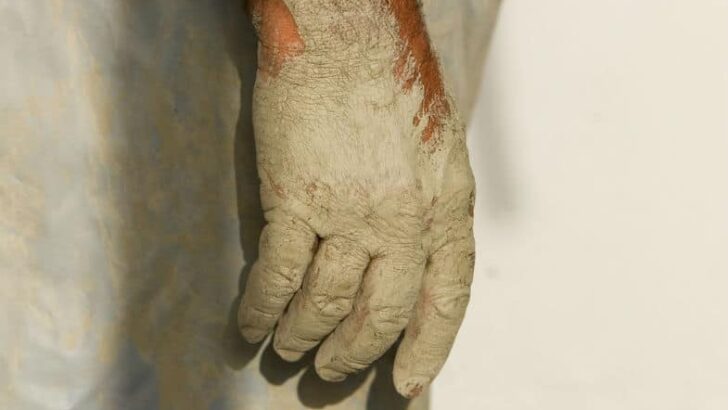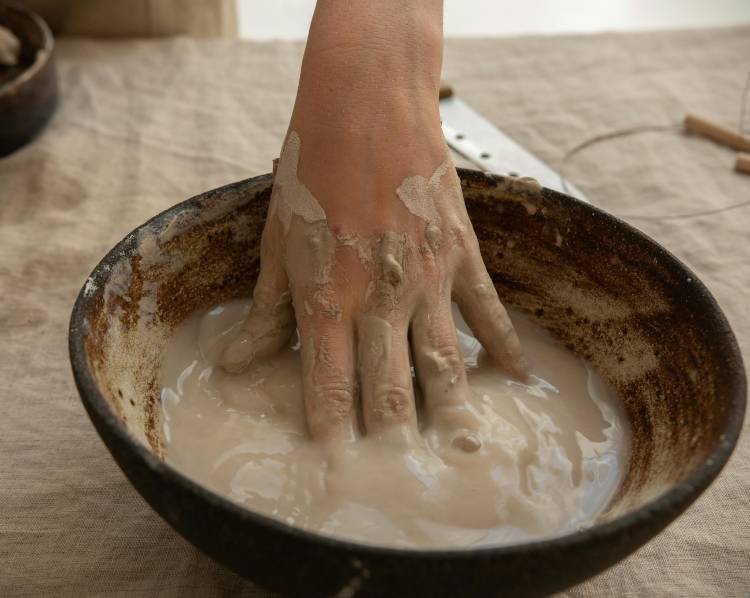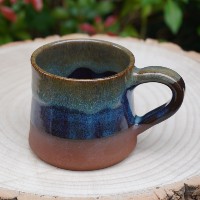Your cart is currently empty!
Dry Hands from Pottery Clay – 10 Tips for Skin and Nails
Published:
Last Updated:

Affiliate Disclaimer
As an affiliate, we may earn a commission from qualifying purchases. We get commissions for purchases made through links on this website from Amazon and other third parties.
My hands are in and out of clay all day, and if I don’t make an effort to look after them, they can become very dry. In this article, we’ll look at some of the things you can do to avoid getting dry hands from pottery clay.
Disclaimer – Before we go on, I wanted to stress that I’m not a dermatologist. I’m a potter who has had to find ways to protect my skin. If you have a skin condition or you are worried that you might have, please consult with a doctor.
First, let’s take a quick look at some of the reasons why pottery clay can dry out your skin.
What Causes Dry Hands from Potters Clay
Here are several reasons why working with pottery clay is tough on skin.
Reason 1:
The water in clay strips out natural oils from your skin, leaving it dry. This can affect skin and nails, leaving nails thin and brittle too.
Reason 2:
Clay is abrasive. Some clay is grainy and can feel like sandpaper on your skin. Grogged clay contains gritty particles of clay that has already been fired and then ground up. Grog can make clay easier to work with but is abrasive on your hands.
Even clay that doesn’t contain grog is made up of clay particles. These particles, or platelets are also hard. Although smooth clay may not feel abrasive like course clay. Over time, it does have an exfoliating effect.
Reason 3:
Although you wash your hands after making pottery, there is often residual clay particles left on your skin. These microscopic particles, nestled on your hands can carry on drying out your skin after you have finished working with the clay.
I notice this when I work with red terracotta clay in particular. Even though I wash my hands well, I can see red/brown clay ingrained in the creases on my hands and around my nails.

10 Tips To Prevent Dry Hands From Pottery Clay
Tip 1: Moisturize Before you Work
Apply a good layer of moisturizer on your hands before you hit the wheel. Rub in a thick moisturizing barrier cream like Vaseline and wipe off the excess with a paper towel. It will give you a layer of protection.
Tip 2: Put a Little Oil in Your Throwing Water
Putting some drops of vegetable oil, olive oil, or baby oil into your throwing water can make a difference.
Every time you dip your hands in, your hands get a bit of protective oil and moisturization. And it doesn’t harm the pottery as any traces of oil will burn off when it is fired.
Tip 3: Use Warm Water When you Throw Pottery
Especially in the winter, if you are working in a cold studio, or pottery shed, it’s a good idea to use warm water. This is especially true when you are throwing on the wheel.
I find that if I use cold water, my hands feel stiffer, and my skin gets red and chapped. Throwing with warm water, along with having a small heater in my pottery shed, stops my hand from getting so dry.
I fill my throwing bowl with water from the hot tap. But I’ve heard of potters who use gadgets like a heated dog bowl to keep their water warm.
Tip 4: Wash Your Hands Regularly
Having a bucket of water handy to wash your hands regularly as you are working is a good idea. Allowing clay to stay caked on your hands will dry your skin out, so wash your hands regularly throughout the day, and soon after you have finished throwing.
How to Clean Clay off Your Hands
Clay is sticky and can be a bit of a job to get off your hands. Here is a quick overview of how to remove clay from your hands…
- If the clay is thick on your hands, use a wooden tool or a rib to scrape as much off your skin as you can.
- Rinse your hands in a bucket of warm water. Avoid getting lots of clay down the sink plug hole, as clay particles will clog up your drains.
- Once you’ve rinsed most of the clay off into a bucket, run your hands under warm water and use soap.
- You can add a little salt when you wash. Rubbing gently with salt or sugar will act as an exfoliant to remove the clay particles. Rub gently as you don’t want the salt to be abrasive.
- A nail scrubbing brush can help to get the clay out from under your nails.
Tip 5: Using a Good Soap Can Prevent Dry Hands from Pottery Clay
One soap that is often recommended amongst potters is African Black Soap. This soap has antibacterial properties, so it’s good for small abrasions on your hands that have been clay. Clay is a breeding ground for mold and bacteria.
African black soap is also anti-fungal (source). It soothes irritated skin, exfoliates, and moisturizes.
Tip 6: Vinegar – An Antidote to Dry Hands from Pottery Clay
Some potters swear by applying cider vinegar to their hands after working with pottery clay. They recommend washing your hands and then spraying your skin with vinegar. You then rub the vinegar into your skin, rinse it off, and apply a layer of moisturizer.
The idea behind this tip is that clay is alkaline, whereas vinegar is relatively acidic. A skin’s natural pH is mildly acidic. By rubbing your hands in vinegar, you are rebalancing the pH of the skin.
Tip 7: Find a Moisturizer that Suits Your Skin
There are some great moisturizers on the market to help with potter’s hands. One of the most popular ones is Bag Balm. I use Bag Balm after throwing and in the evenings, and it keeps my skin moisturized.
Bag Balm Moisturizer
It was originally formulated in 1899 to sooth cow’s udders, hence the name ‘Bag Balm’. It was designed to heal abrasions on cows being milked.
Legend has it that farmers applying it to cows found it stopped their hands from becoming chapped in the winter. And these days it’s used by explorers in extreme conditions like the North Pole.
There are a couple of other cow related products that are popular amongst potters. They are Udder Balm and Udderly Smooth. Like Bag Balm, they were originally designed to sooth cows udders, but they are also sold for humans. Because they promote the healing and soothing of dry skin, they are a good option for potters.
Other Non-Cow Related Moisturizers!
Not all intensive moisturizers suitable for potters were originally designed for cows! Here are some alternatives often used by potters:
Workman’s Friend: This is non-greasy and fragrance-free and is said to have anti-inflammatory properties.
Working Hands: An inexpensive hand cream, that creates a protective barrier on your skin.
Aquaphor: is described by the makers as being a healing ointment, suitable for cracked hands, minor cuts, and burns. It is 41% Petrolatum, so it is quite thick. But it doesn’t stay thick or greasy and it has a good reputation amongst potters with dry skin.
Corn Huskers Lotion: This lotion was originally developed for Iowa Farmers, whose hands were exposed to the elements daily. It’s not greasy and absorbs quickly, however, some say the scent is a bit sweet and strong.
Tip 8: Make Your Own Bespoke Moisturizer – Some Simple Recipes
If pottery clay is making your skin dry and you’d rather avoid commercially produced cream, you can try making your own. It can be quite straightforward.
I make an ointment that I put on my hands in the evening, which is made from two simple ingredients. Here is the recipe:
Recipe 1
- 50% Cold pressed castor oil
- 50% carrier oil, like almond oil or coconut oil
Recipe 2
- 80g olive oil
- 20g beeswax
Recipe 3
- Shea butter
- Beeswax
- Coconut oil or butter
- Vitamin E drops
- Essential oils for a nice smell
Tip 9: Sleeping with Moisturizing Gloves On to Heal Dry Hands from Pottery Clay
Another simple idea for looking after potter’s hands is to buy some moisturizing gloves. These are simple, lightweight gloves that you can sleep in.
You can apply a generous amount of your preferred moisturizer to your hands then put on the gloves. The gloves keep the moisturizer on your skin so it’s working overnight.
Tip 10: Throwing with Gloves on to Prevent Dry Hands from Pottery Clay
Another suggestion is to wear gloves when you are making pottery. Wearing gloves makes it harder to feel the clay and can be awkward at first. However, some potters have skin conditions such as eczema that mean they have to learn how to work with gloves on.
With time, you can learn to adapt and develop a feel for the clay, even if you are wearing gloves.
Ideally the gloves should be snug fitting, so that they don’t snag and pull on the clay. I know a potter who wears gloves when he works, and he buys gloves a size smaller than he needs to make sure they are a close fit. Nitrile gloves are a good option, because they are tough but thin.

Visit The Pottery Wheel Store
Fancy treating yourself to some homemade pottery? Looking for a unique gift? Check out my handmade pottery store…
Final Thoughts
So, does pottery make your hands rough? Yes, it can. However, it depends on how often you are using clay. If you are planning to take a weekly class, and practice a few times a week, then your skin should be fine. Alternatively, if you use clay every day, it’s more likely to have a drying effect on your skin and nails. That being said, if you invest a bit of time in your skin at the end of your session, you can avoid getting dry hands from pottery clay.




